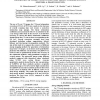Free Online Productivity Tools
i2Speak
i2Symbol
i2OCR
iTex2Img
iWeb2Print
iWeb2Shot
i2Type
iPdf2Split
iPdf2Merge
i2Bopomofo
i2Arabic
i2Style
i2Image
i2PDF
iLatex2Rtf
Sci2ools
ISBI
2008
IEEE
2008
IEEE
Comparative assessment of different energy mapping methods for generation of 511-keV attenuation map from CT images in PET/CT sy
The use of X-ray CT images for CT-based attenuation correction (CTAC) of PET data results in the decrease of overall scanning time and creates a noise-free attenuation map (μmap). The linear attenuation coefficient (LAC) measured with CT is calculated at the x-ray energy rather than at the 511 keV. It is therefore necessary to convert the linear attenuation coefficients obtained from the CT scan to those corresponding to the 511 keV. Several conversion strategies have been developed including scaling, segmentation, hybrid, bilinear and dual-energy decomposition methods. The aim of this study is to compare the accuracy of different energy mapping methods for generation of attenuation map form CT images. An in-house made polyethylene phantom with different concentrations of K2HPO4 was used in order to quantitatively measure the accuracy of the nominated methods, using quantitative analysis of created μmaps. The generated μmaps using different methods compared with theoretical values ...
| Added | 31 May 2010 |
| Updated | 31 May 2010 |
| Type | Conference |
| Year | 2008 |
| Where | ISBI |
| Authors | Maryam Shirmohammad, Mohammad Reza Ay, Saeed Sarkar, Hossein Ghadiri, Arman Rahmim |
Comments (0)

